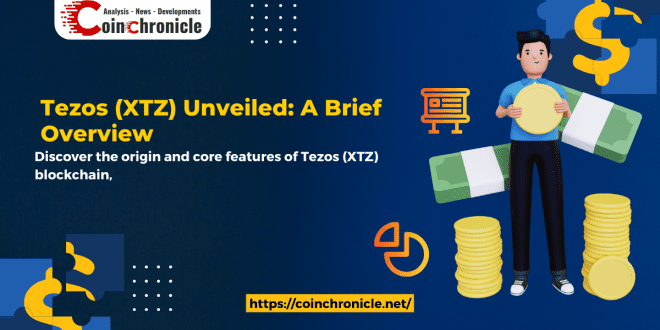Discover the origin and core features of Tezos (XTZ) blockchain, explore its consensus mechanism and learn how to stake in Tezos with this guide. Explore Tezos’ impact on blockchain technology.Tezos (XTZ) Unveiled: A Brief Overview
In the ever-evolving world of blockchain technology, Tezos (XTZ) has emerged as a prominent player, offering a unique approach to decentralized finance and digital assets. From its origins to its impact on the blockchain industry, Tezos has garnered attention for its innovative consensus mechanism and the user-friendly staking process. In this blog post, we will provide a comprehensive look at Tezos, covering its introduction, core features, consensus mechanism, staking guide, and its overall impact on blockchain technology.
Whether you’re a seasoned cryptocurrency enthusiast or just starting to dive into the world of digital assets, this overview of Tezos will provide valuable insight into one of the most exciting projects in the blockchain space. Join us as we explore the fundamental aspects of Tezos and gain a deeper understanding of its role in shaping the future of decentralized finance.
Introduction to Tezos (XTZ)
Tezos (XTZ) is a blockchain network that is designed to evolve. It was founded by Arthur Breitman and Kathleen Breitman in 2014 and launched in 2018 after a successful Initial Coin Offering (ICO) that raised over $230 million. Tezos is unique in the sense that it employs a self-amending cryptographic mechanism to achieve consensus.
In Tezos, token holders have the ability to vote on proposed amendments to the protocol. This process ensures that the network can adapt and upgrade itself over time without needing to fork the blockchain. The project aims to address the governance and upgrade issues that have been present in other blockchain networks.
One of the key features of Tezos is its on-chain governance, which allows stakeholders to participate in the decision-making process for protocol upgrades. Additionally, it uses a smart contract language called Michelson, which is designed to facilitate formal verification, a technique used to mathematically prove the correctness of the code.
The native cryptocurrency of Tezos is called XTZ, and it is used to participate in the network’s governance and to pay for transaction fees. The network also supports delegated proof of stake (DPoS), where token holders can delegate their coins to a baker, who will validate transactions and create new blocks on their behalf.
The Origin of Tezos
Tezos was created by Arthur Breitman, a former analyst at Goldman Sachs, and his wife Kathleen Breitman, with the aim of addressing some of the key challenges facing existing blockchain platforms. The project was first introduced in a white paper in 2014, outlining a self-amending cryptographic ledger. The Breitmans proposed a new protocol that could evolve and adapt over time, without the need for hard forks, to address the governance, security, and scalability concerns that had arisen in other blockchains.
In 2017, the Tezos Foundation conducted one of the largest initial coin offerings (ICOs) to date, raising over $232 million. However, the project faced some internal disputes and legal challenges following the ICO, which delayed the launch of the network. Despite these hurdles, the Tezos blockchain was finally launched in September 2018, marking a significant milestone for the project.
The origin of Tezos can be traced back to the desire to create a more governance-oriented and adaptable blockchain platform. The vision put forth by the Breitmans in their initial white paper laid the groundwork for a protocol that strives to overcome the limitations of existing blockchains, positioning itself as a self-amending ledger that can evolve to meet the diverse needs of its users and developers.
From its inception to its eventual launch, the journey of Tezos illustrates the dedication and persistence of its creators in bringing their vision to fruition, and the impact of the project extends beyond just the technology, influencing the broader conversation around blockchain governance and innovation.
Core Features of the Tezos Blockchain
Tezos is a blockchain platform that has several unique features which set it apart from other cryptocurrencies. One of the core features of Tezos is its on-chain governance model. This means that token holders have the ability to vote on proposed protocol upgrades and changes. This democratic approach to governance ensures that the platform can evolve and adapt over time, without the need for hard forks.
Another key feature of Tezos is its use of formal verification. This is a method of ensuring that smart contracts and other aspects of the platform are bug-free and secure. By using formal verification, Tezos aims to minimize the risk of vulnerabilities and hacks, making it a more reliable and trustworthy platform for users.
Tezos also employs a unique consensus algorithm called Liquid Proof of Stake (LPoS). This allows token holders to delegate their stake to other network participants, known as bakers. These bakers are responsible for creating new blocks and validating transactions, and in return, they receive a portion of the rewards for their efforts. This incentivizes participation in the network and helps to maintain its security and stability.
Lastly, Tezos is designed to be a self-amending blockchain, meaning that it can upgrade and improve itself without requiring contentious hard forks. This flexible approach to development allows the platform to adapt to changing market conditions and technological advancements, ensuring that it remains competitive and innovative in the fast-paced world of blockchain technology.
Tezos’ Consensus Mechanism Explained
Tezos, a self-amending blockchain, utilizes a unique consensus mechanism known as Liquid Proof of Stake (LPoS). LPoS allows token holders to play a role in the consensus protocol, similar to other proof of stake systems. However, Tezos takes a different approach by introducing a formal governance process that enables stakeholders to vote on proposed protocol upgrades. This consensus mechanism enhances the decentralization of the network, giving power to the community.
One of the core features of Tezos’ LPoS is its baking and endorsing concept. In Tezos, participants who hold a certain number of tokens can become bakers and endorsers. Bakers are responsible for creating new blocks, and endorsers are tasked with verifying the validity of these blocks. This dual-layer system ensures the security and efficiency of the blockchain network.
Moreover, Tezos’ LPoS consensus mechanism is designed to be self-amending, allowing for seamless upgrades and improvements. Through on-chain governance, token holders can propose and vote on protocol amendments, making Tezos a dynamic and ever-evolving blockchain platform. This democratic approach to consensus sets Tezos apart from other cryptocurrencies.
In conclusion, Tezos’ Liquid Proof of Stake consensus mechanism is a key component that underpins the blockchain’s functionality and governance. By empowering token holders to participate in the consensus protocol and decision-making processes, Tezos achieves a remarkable level of decentralization and community-driven development.
Staking in Tezos: A User’s Guide
Staking in Tezos is a way for token holders to help secure the network by participating in the consensus mechanism. It involves actively participating in block creation and validation on the blockchain. The process of staking in Tezos is different from traditional proof-of-work systems, as it uses a proof-of-stake mechanism.
Tezos employs a liquid proof-of-stake system where token holders can delegate their tokens to bakers, who are responsible for creating and validating blocks. In return for delegating their tokens, holders receive rewards in the form of additional XTZ tokens.
One of the key benefits of staking in Tezos is the ability for token holders to actively participate in the governance of the network. By delegating their tokens to bakers who align with their values, holders can have a say in important protocol upgrades and decisions.
Overall, staking in Tezos provides an opportunity for token holders to not only earn rewards but also play an active role in the network’s consensus mechanism and governance.
Tezos’ Impact on Blockchain Technology
Tezos has been making waves in the world of blockchain technology, and its impact is significant. One of the key areas in which Tezos has had a huge impact is in terms of governance. The platform utilizes a unique mechanism for governance, allowing token holders to vote on proposed protocol upgrades and changes. This decentralized approach to governance has set a new standard for blockchain projects, empowering the community to have a direct say in the future of the platform.
Another area where Tezos has made a significant impact is in terms of security. The platform’s use of formal verification, a technique for ensuring the correctness of smart contracts and protocol amendments, has set a new standard for blockchain security. This has helped to mitigate the risk of bugs and vulnerabilities, making Tezos a more secure and reliable platform.
Tezos also stands out in terms of scalability. Its focus on on-chain governance and the ability to evolve over time means that the platform is well-equipped to handle the demands of a rapidly growing ecosystem. This scalability is crucial for the long-term success of blockchain technology, and Tezos is at the forefront of this important development.
Overall, Tezos has had a significant impact on the world of blockchain technology. Its innovative approach to governance, security, and scalability has set a new standard for the industry, and its influence is likely to continue growing in the years to come.
 Crypto Journal: Analyses, News, and Developments – Coin Chronicle Platform Coin Chronicle is your go-to source in the dynamic world of cryptocurrencies.
Crypto Journal: Analyses, News, and Developments – Coin Chronicle Platform Coin Chronicle is your go-to source in the dynamic world of cryptocurrencies.




